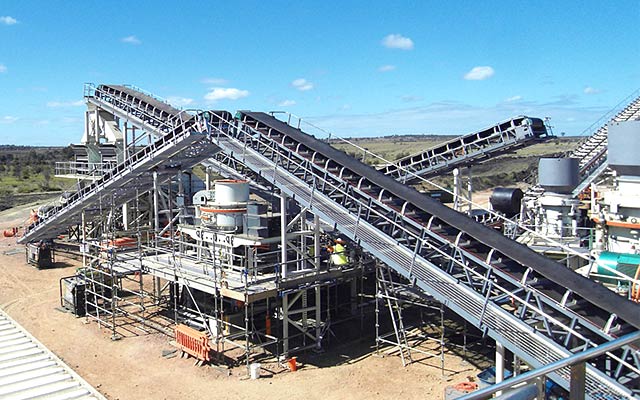A stone crushing and screening plant designed for producing 6-28mm aggregate involves several critical stages and components to ensure efficient operation and high-quality output. Here’s an overview of such a plant:
Overview
A stone crushing and screening plant is essential for producing various grades of crushed stone, which are used in construction, road building, and other infrastructure projects. The plant’s primary function is to crush and screen raw material (typically rocks) into desired sizes. For a plant focusing on 6-28mm aggregate, the process involves crushing larger stones into smaller pieces and then sorting them into specific size ranges.

Key Components
- Feeder
The feeder’s role is to deliver the raw material into the crushing system. It is typically a vibrating feeder that ensures a steady and controlled flow of material to the primary crusher. This component must be robust to handle varying material sizes and quantities.
- Primary Crusher
The primary crusher breaks down the large rocks into smaller, more manageable pieces. Common types of primary crushers include jaw crushers and impact crushers. For producing 6-28mm aggregate, a jaw crusher is often preferred due to its ability to handle large rock sizes and produce a range of output sizes.
- Secondary and Tertiary Crushers
After the primary crushing stage, the material is further reduced by secondary and tertiary crushers. These crushers refine the material to achieve the desired size range of 6-28mm. Cone crushers and impact crushers are typically used in these stages. Cone crushers are effective in producing uniform-sized aggregates, while impact crushers are better for creating cubical shapes.
- Screening System
The screening system is crucial for sorting the crushed material into various sizes. It typically consists of vibrating screens or a series of screens with different mesh sizes. The screening process separates the aggregate into various size fractions, including the targeted 6-28mm range. Advanced plants may use multiple decks of screens to achieve finer sorting.
- Conveyors
Conveyors transport the material between different stages of the crushing and screening process. They are essential for maintaining a smooth flow of material and minimizing manual handling. Conveyors must be durable and designed to handle the specific characteristics of the processed material.
- Control System
Modern plants are equipped with advanced control systems that monitor and manage the entire process. This includes automated controls for adjusting crusher settings, monitoring feed rates, and managing the screening process. The control system helps optimize plant performance and ensure consistent product quality.
Process Flow
- Material Feeding: Raw material is fed into the primary crusher via the feeder.
- Primary Crushing: The primary crusher reduces large rocks into smaller pieces.
- Secondary and Tertiary Crushing: The material is further reduced by secondary and tertiary crushers to achieve the desired size range.
- Screening: The crushed material is screened to separate it into various size fractions, focusing on the 6-28mm range.
- Conveying: The screened aggregate is transported to storage or directly to customers.
A stone crushing and screening plant for producing 6-28mm aggregate is a sophisticated system that requires careful planning and execution. The efficiency of the plant depends on the proper selection and integration of crushers, screens, conveyors, and control systems. By ensuring each component works seamlessly together, the plant can produce high-quality aggregate that meets industry standards and customer requirements.
